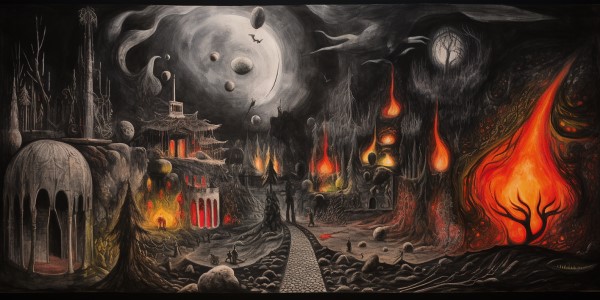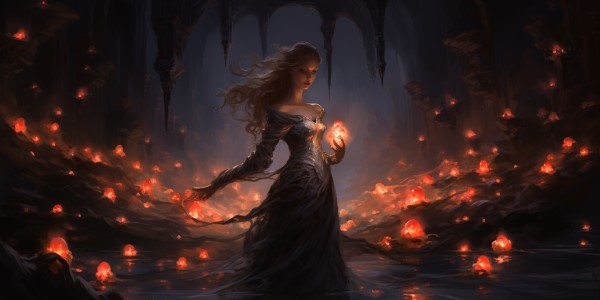KidZone Geography: Greece
The Underworld: Greek Mythology's Realm of Souls
In the captivating tapestry of Greek mythology, the Underworld holds a place of intrigue and solemnity, serving as the final destination for souls after their earthly journey concludes. This shadowy domain, hidden deep beneath the earth and veiled from the living, is ruled by the god Hades and his queen, Persephone, whose annual return to the surface world brings spring's bloom and whose descent marks the winter's chill. The Underworld is not merely a place of darkness and despair but a complex realm with its own order and justice, reflecting the ancient Greeks' beliefs about death, the afterlife, and the moral balance that governs both the living and the dead.

Divisions of the Underworld
The Greek Underworld is intricately structured, comprising various regions tailored to the souls residing within:
- Elysium (The Elysian Fields): A paradisiacal expanse reserved for the righteous and heroic, where eternal peace and happiness reign.
- Tartarus: A deep, gloomy pit used as a dungeon of torment for the wicked and as the prison for the Titans, showcasing the theme of divine retribution.
- Asphodel Meadows: A neutral place where the souls of ordinary people, neither notably virtuous nor evil, spend their afterlife in a state of forgetful existence.
- The Isles of the Blessed: A blissful realm for those who have achieved Elysium three times, offering an even greater reward for the exceptionally virtuous.
The Journey to the Underworld
The passage to the Underworld is fraught with trials, beginning with a voyage across the River Styx, where the ferryman Charon transports the souls of the deceased. This journey necessitates the payment of an obolus (a coin) placed in the mouth of the deceased at burial, serving as fare for Charon. Those unburied or without fare wander the near shores for a hundred years, reflecting the Greek emphasis on proper burial rites.
Guardians and Inhabitants
The Underworld is home to various beings, each with a role in the realm's maintenance and the processing of souls:
- Cerberus: The fearsome three-headed dog stands guard at the Underworld's entrance, preventing the living from entering and the dead from escaping.
- The Judges of the Dead: Figures like Minos, Rhadamanthus, and Aeacus preside over the souls, judging their deeds and assigning them to their rightful place in the afterlife.
- The Furies (Erinyes): Punishers of moral crimes, these deities avenge wrongs and ensure that divine justice is served.
The Underworld in Mythology and Culture
The Greek Underworld is more than a realm of the dead; it is a symbol of the unknown, a reflection of the Greeks' understanding of life, death, and the ethical principles governing both. Stories of heroic descents into the Underworld, such as those of Orpheus, Heracles, and Odysseus, highlight themes of love, redemption, and the quest for knowledge, emphasizing the indomitable spirit of humanity in its confrontation with the immutable forces of nature and fate.
Through its rich lore and complex structure, the Greek Underworld captures the essence of ancient beliefs and the human condition, offering timeless narratives that explore the depths of the psyche, the mysteries of existence, and the eternal cycle of life and death.
The Greek Myth of Persephone and Hades
In an age draped in the mists of myth, there lived Persephone, the embodiment of spring's delight, daughter to Demeter, the nurturing goddess of the harvest. Her laughter was the melody of life itself, her movements the gentle sway of blossoming flowers under the sun's tender gaze.

On a day marked by fate, as Persephone wandered amidst the splendor of nature's canvas, the earth beneath her quivered and split. From this chasm of shadow and silence, Hades, lord of the Underworld, beheld her luminous spirit and, ensnared by a love profound and consuming, ascended from his dark dominion and spirited her away to his realm of eternal dusk, leaving a void where once there was light.
The absence of Persephone cast a pall over the land; Demeter's heart was cloaked in despair, her sorrow so deep that the once fertile fields lay barren, the trees bereft of their verdure, the skies a mirror of her endless mourning. The world, caught in the grip of an unyielding winter, languished for the return of its spring.
Meanwhile, in the Underworld, amidst souls wandering in shades of forgetfulness, Persephone discovered a realm where even the faintest flicker of her grace illuminated the darkest corners. Though a captive, her essence became a beacon for the lost and a solace to the heart of Hades, drawing forth a love that bridged the chasm between life and death.

Hearing the mortal world's plea, Zeus decreed that Persephone be returned to her mother. Yet, destiny demanded its tribute: Persephone had partaken of the pomegranate, the fruit of the Underworld, sealing her fate to return to Hades for a portion of each year.
As Persephone prepared to leave the Underworld, she encountered Charon, the silent ferryman, his boat ready to glide across the Stygian waters that mark the boundary between the living and the dead. With a nod of understanding, Charon guided her across the river, a passage from shadow back into the light.

Upon Persephone's return, the earth responded with a surge of life; where her feet touched, flowers sprang forth, trees donned their lush attire, and the air filled with the songs of birds, heralding the rebirth of spring. Yet, as the wheel of the year turned, Persephone would journey once more to the Underworld, her departure casting a veil of winter over the world, her return a celebration of life's renewal.
This eternal cycle, marked by Persephone's passage to and from the Underworld, weaves the tapestry of the seasons, a story of loss and reunion, darkness and light, a reminder of the enduring rhythm of nature and the indomitable spirit of love that transcends the boundaries of worlds.

